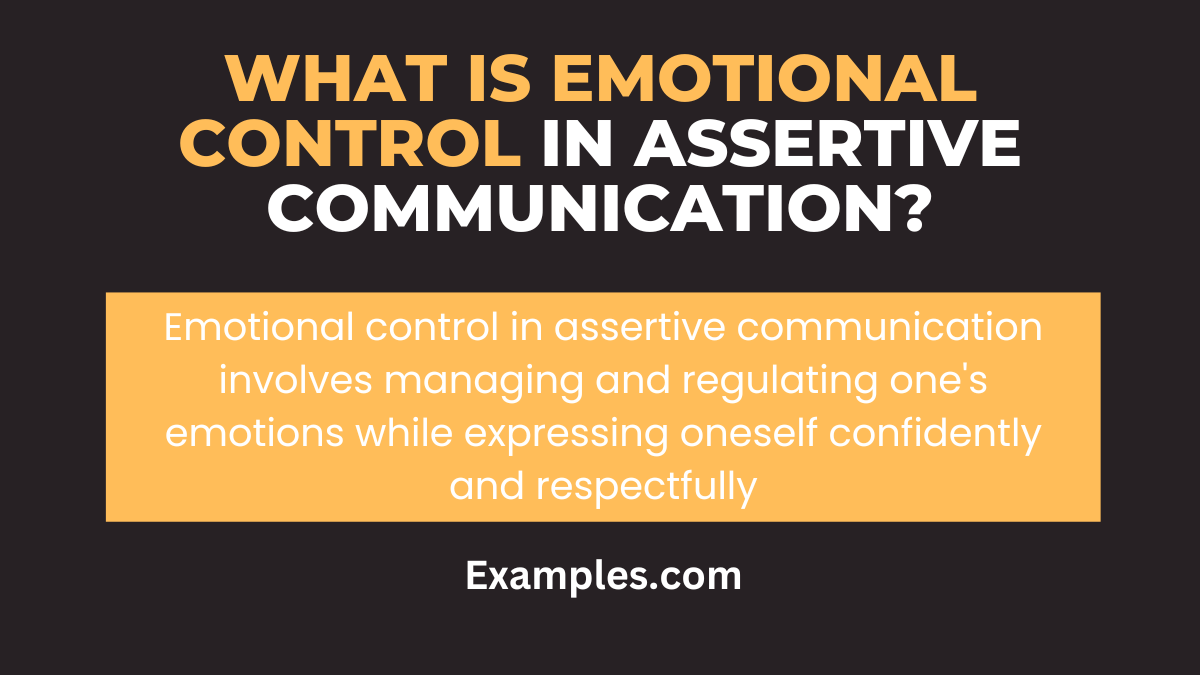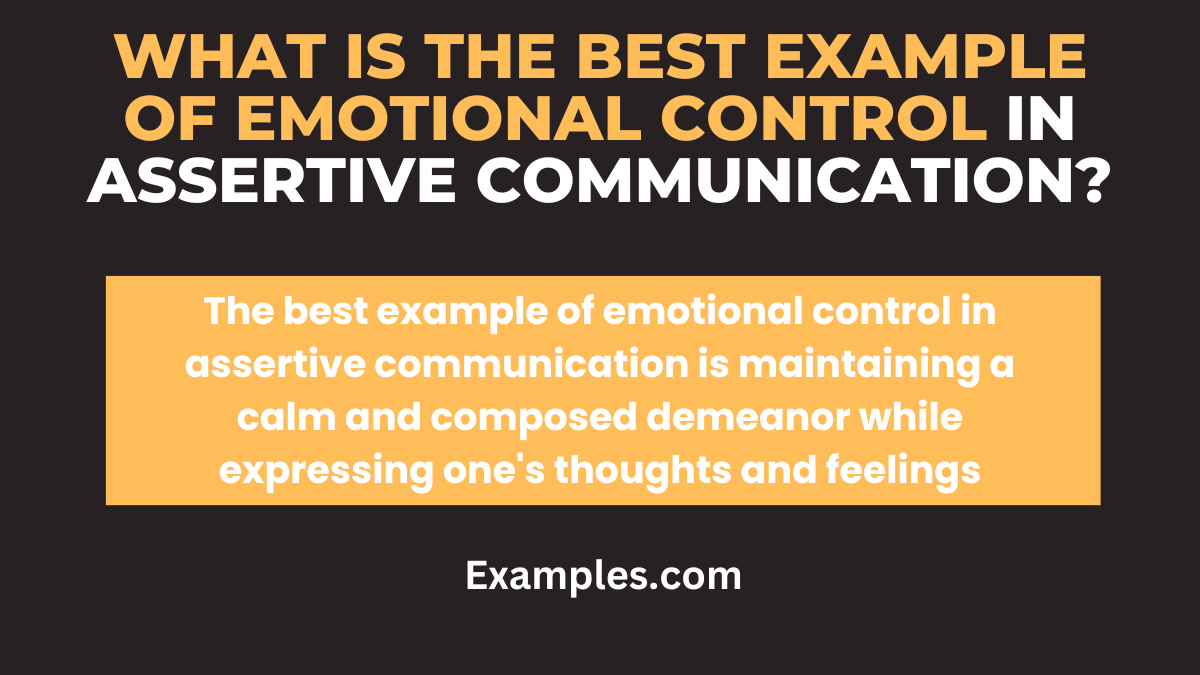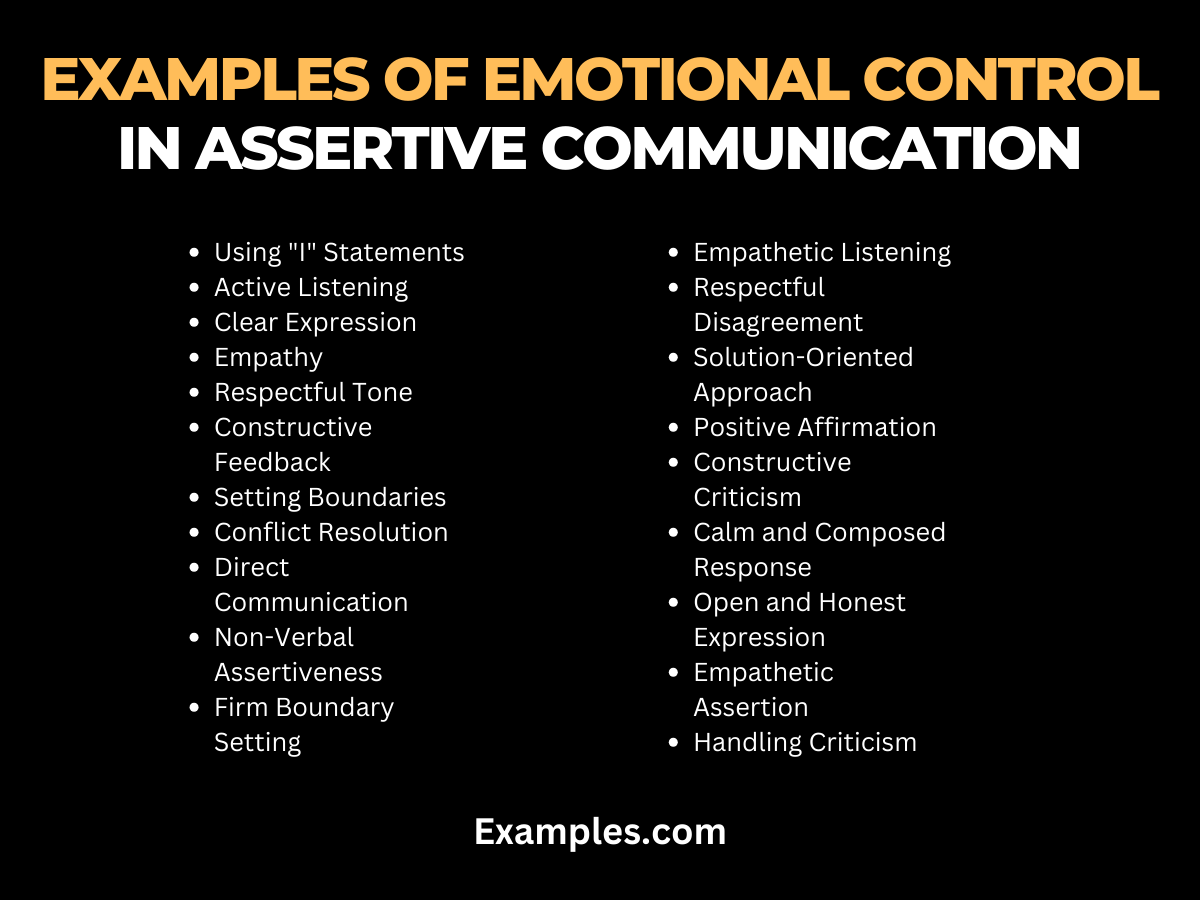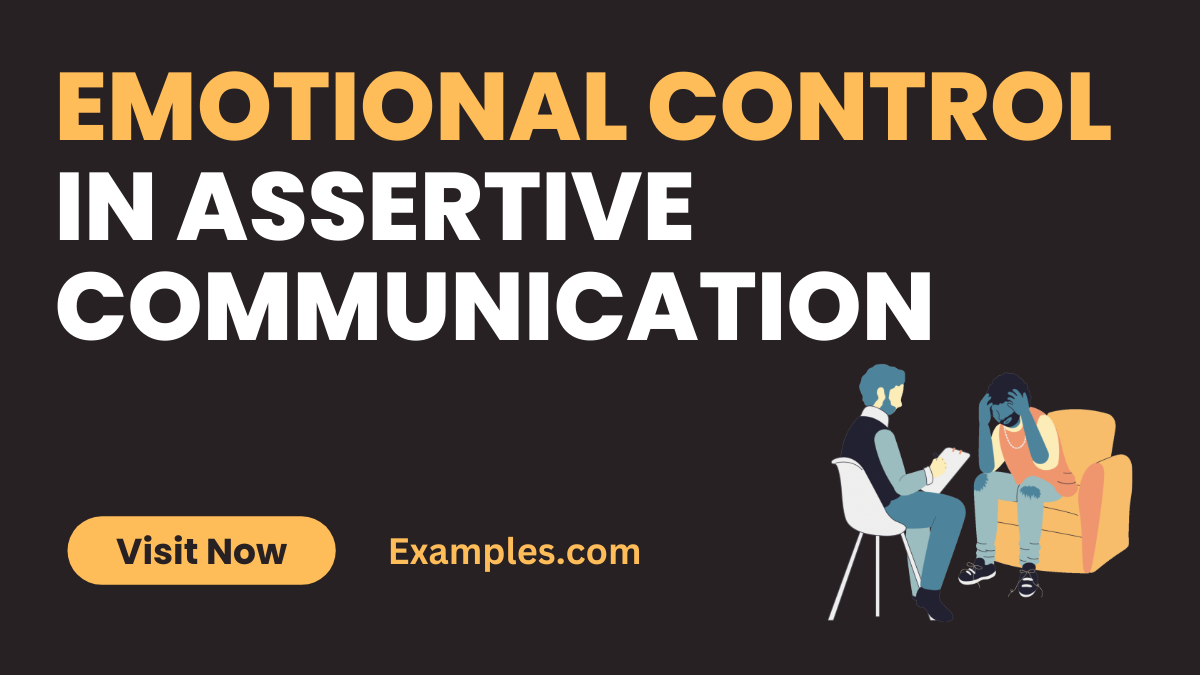19+ Emotional Control in Assertive Communication Examples
Emotional control plays a pivotal role in effective assertive communication, serving as the cornerstone for clear, respectful, and empathetic interactions. In this comprehensive guide, we delve into the nuances of managing emotions while maintaining assertiveness. Learn how to balance assertive expression with emotional intelligence, ensuring your communication is not just heard, but also felt and respected. Embrace the art of “Emotional Control in Assertive Communication” to transform your interpersonal skills.
What is Emotional Control in Assertive Communication?

Emotional control in assertive communication refers to the ability to manage and express one’s emotions in a way that is clear, respectful, and direct. This skill is essential for successful interactions, as it allows individuals to convey their thoughts and feelings without aggression or passivity. By mastering Emotional Control in Assertive Communication, individuals can navigate complex conversations with poise and confidence, ensuring their message is delivered effectively and respectfully.
Assertive communication is not just about what you say, but also how you say it. Emotional control enables you to maintain a Respectful Tone in Assertive Communication, ensuring that your message is conveyed in a way that is both firm and empathetic. It’s about finding the balance between expressing your needs and respecting others’ perspectives.
What is the Best Example of Emotional Control in Assertive Communication?

Emotional control in assertive communication is exemplified when a person calmly and confidently expresses their feelings or needs without succumbing to anger or passivity. For instance, imagine a scenario where an employee disagrees with their manager’s decision. Instead of reacting impulsively or aggressively, the employee takes a moment to compose themselves and then articulates their viewpoint using I statements in assertive communication, such as, “I understand the rationale behind your decision, but I feel that my approach might be more effective in this situation.”
20 Examples of Emotional Control in Assertive Communication

Maintaining emotional control is vital in assertive communication. It involves expressing oneself calmly and effectively, even in challenging situations. This skill balances self-expression with respect for others, avoiding aggression or passivity. By mastering emotional control, one can communicate more clearly and confidently.
1. Using “I” Statements
Example: “I feel concerned when meetings start late, as it impacts our schedule.”
This approach personalizes feelings without blaming others.
2. Active Listening
Example: “I understand your point. Let’s explore this together.”
Shows attentiveness and respect for the speaker’s views.
3. Clear Expression
Example: “I would like to discuss a solution that benefits both of us.”
Directly states intentions without ambiguity.
4. Empathy
Example: “I see this is important to you; let’s find a middle ground.”
Acknowledges others’ feelings, fostering mutual understanding.
5. Respectful Tone
Example: “I appreciate your efforts and would love to add my perspective.”
Uses a polite and considerate tone.
6. Constructive Feedback
Example: “Your report was good; adding more data could enhance it further.”
Offers positive suggestions for improvement.
7. Setting Boundaries
Example: “I cannot attend the meeting at that time, but I’m available later.”
Communicates limits clearly.
8. Conflict Resolution
Example: “Let’s find a solution that addresses both our concerns.”
Aims for a win-win outcome.
9. Direct Communication
Example: “My goal is to complete this project efficiently and effectively.”
States objectives without ambiguity.
10. Non-Verbal Assertiveness
Example: Maintaining eye contact while speaking.
Shows confidence and engagement.
11. Empathetic Listening
Example: “I hear what you’re saying and want to understand better.”
Indicates a genuine interest in others’ viewpoints.
12. Respectful Disagreement
Example: “I see your point, but I have a different perspective.”
Disagrees without disrespect.
13. Solution-Oriented Approach
Example: “Let’s focus on finding a solution that works for both of us.”
Concentrates on resolving issues.
14. Firm Boundary Setting
Example: “I need to prioritize my tasks, so I can’t take on extra work right now.”
Communicates limits firmly but politely.
15. Positive Affirmation
Example: “I value your input and look forward to collaborating.”
Encourages and values others’ contributions.
16. Constructive Criticism
Example: “Your idea is innovative, but let’s consider its feasibility.”
Provides constructive feedback while acknowledging effort.
17. Calm and Composed Response
Example: “Let’s take a moment to think this through calmly.”
Encourages rational thinking in heated situations.
18. Open and Honest Expression
Example: “I honestly feel that we need a different approach here.”
Promotes transparency in communication.
19. Empathetic Assertion
Example: “I understand your frustration, and here’s my viewpoint.”
Combines understanding with clear self-expression.
20. Handling Criticism
Example: “Thank you for the feedback; I’ll consider your points.”
Responds to criticism positively, showing willingness to grow.
Incorporating these Assertive Communication Skills and Assertive Communication Examples in daily interactions can significantly enhance communication effectiveness and relationships.
Why You Should Control Your Emotions in Assertive Communication?
Controlling emotions in assertive communication is crucial because it:
- Maintains Respect: It ensures that both parties feel respected and valued, avoiding escalation into conflict.
- Enhances Clarity: It keeps the focus on the message, not the emotions, leading to clearer communication.
- Builds Credibility: Emotional control establishes your reputation as a calm, rational, and professional individual.
- Facilitates Understanding: It helps in being heard and understood, as emotional outbursts can overshadow the underlying message.
- Promotes Problem Solving: It fosters a collaborative atmosphere where solutions can be found, rather than getting stuck in emotional responses.
- Reduces Stress: Keeping emotions in check can prevent the physical and mental stress associated with confrontational encounters.
- Encourages Emotional Intelligence: It aids in developing emotional intelligence, which is key in personal and professional relationships.
- Supports Positive Relationships: It lays the foundation for positive and long-lasting relationships both in personal and professional settings.
Importance of Emotional Control in Assertive Communication
- Prevents Miscommunication: When emotions are controlled, the chances of misinterpretation due to emotional bias are minimized.
- Builds Self-Confidence: Regular practice of emotional control can significantly boost self-confidence in communication.
- Enhances Listening Skills: Being in control of your emotions allows you to engage in active listening in assertive communication, which is critical for understanding the other party’s perspective.
- Encourages Mutual Respect: Emotional control is a sign of respect for the other person’s views and feelings.
- Fosters Positive Work Environment: In the workplace, it contributes to a more harmonious and productive environment.
- Aids in Conflict Resolution: It plays a key role in resolving conflicts in a constructive and peaceful manner.
- Improves Decision Making: Emotionally controlled communication leads to clearer thinking, which is essential for making sound decisions.
- Promotes Personal Growth: It not only improves communication skills but also contributes to overall personal development.
Mastering emotional control in assertive communication is crucial for effective interaction. This guide provided valuable tips for maintaining composure and empathy in various situations. By understanding and managing emotions, individuals can enhance their assertiveness, leading to more productive and respectful communication. Remember, emotional control is the cornerstone of assertive communication success.



